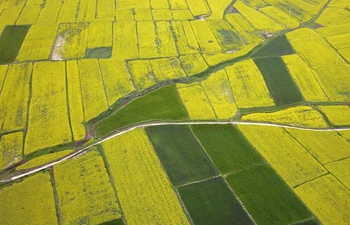GENEVA, July 18 (Xinhua) -- World Health Organization (WHO) Director-General Tedros Adhanom Ghebreyesus on Wednesday declared the Ebola virus disease outbreak in the Democratic Republic of the Congo (DRC) a Public Health Emergency of International Concern.
Saying that everything possible is need to be done now, UN Under-Secretary-General for Humanitarian Affairs and Emergency Relief Coordinator Mark Lowcock also said earlier this week that world must try the best to avoid the DRC outbreak of Ebola reaching the scale of the outbreak in West Africa five years ago, when more than 10,000 lives were lost before a multi-billion-dollar response brought the cases down to zero.
The following are some facts and figures about the current outbreak and about the virus:
On August 1 of 2018, the Ministry of Health of the DRC declared a new outbreak of Ebola virus disease in North Kivu province.
As of July 16 of 2019, there had been 2,522 confirmed or probable cases, including 136 health workers affected, and the confirmed or probable deaths totaled 1,698 in the country.
The latest WHO risk assessment remains that the risk of spread in DRC and the region is "very high", but the risk of spread outside the region is low.
The intensity of the epidemiological situation is fluctuating, with about 80 new cases reported weekly.
There is continued shifting of hotspots and associated risks. There is continued seeding to new or previously cleared areas but thus far without sustained local transmission.
For the DRC, factors affecting the outbreak of the Ebola include population movement in highly densely populated areas, weak infection and prevention control practices in many health facilities, complex political environment, continued reluctance in the community and the ongoing unstable security situation.
Ebola virus disease (formerly known as Ebola haemorrhagic fever) is a rare but severe, often fatal illness. Death rates have varied from 25 percent to 90 percent in past outbreaks.
The Ebola virus was first identified in 1976 when 2 simultaneous outbreaks occurred, one in Yambuku, a village not far from the Ebola River in the DRC and the other in a remote area of Sudan.
The origin of the virus is unknown, but current evidence suggests that fruit bats (Pteropodidae) may be a host.
People become infected with Ebola either through contact with infected animals (usually following butchering, cooking or eating) or through contact with the bodily fluids of infected humans.
During an outbreak, those at higher risk of infection are: health workers; family members or others in close contact with infected people; mourners who have direct contact with bodies during burial rituals.

















